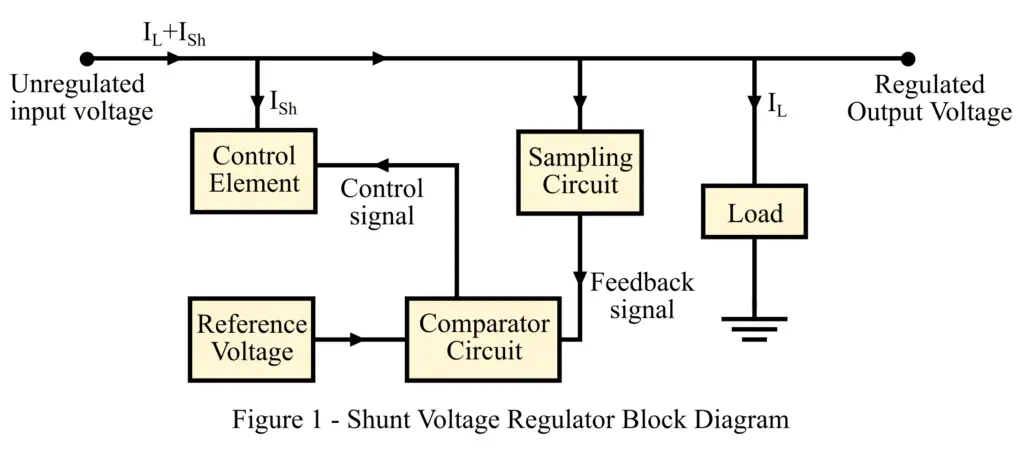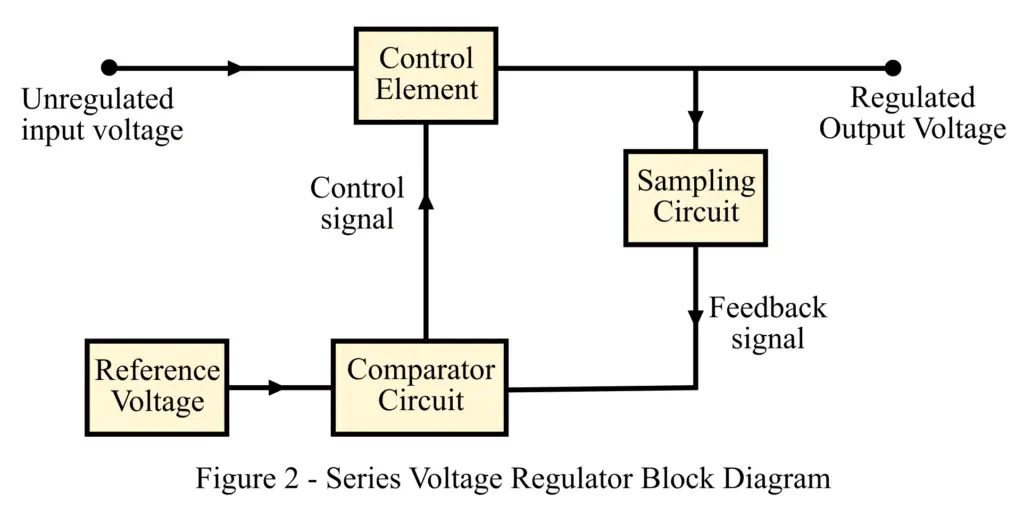This article describes the shunt and series regulator and the differences between them. The main focus of this article is to distinguish between two kinds of voltage regulators namely – Shunt and Series voltage regulators.
What is a Voltage Regulator?
A voltage regulator is defined as an electronic device used in an electronic circuit to maintain a constant voltage at the output of any electronic circuit within the desired limits, irrespective of the variations in input voltage supplied or load current.
It plays a vital role in transforming unregulated DC power supply to regulated DC supply with no significant variations in the output voltage generated. A voltage regulator is also sometimes referred to as a control element. Based on the arrangement or placement of the control element. The voltage regulator in an electronic circuit can be of the following two types –
- Shunt voltage regulator
- Series voltage regulator
What is a Shunt Voltage Regulator?

Figure 1 above illustrates that a shunt voltage regulator is always connected in parallel with the load in an electronic circuit. It is observed from Figure 1 that the input voltage applied to the circuit splits into the shunt voltage regulator or the control element and the rest of the current moves to the load. The shunt current (Ish) plays a vital role in maintaining a constant and invariable output voltage at the output.
A sampling circuit and comparator circuit are also present. The sampling circuit present in the electronic circuit generates a feedback signal to the comparator circuit, which in turn compares the applied input reference voltage and the feedback signal to produce a control signal as the difference. This control signal is basically the amount of current to be provided to the shunt voltage regulator element in order to maintain constant voltage output at the load side.
What is Series Voltage Regulator?

In the case of a series voltage regulator, the control element or the voltage regulator is connected in series with the load at the output as shown in Figure 2 above. The series voltage regulator determines the amount of input voltage reaching the load element at the output end of the circuit.
The series voltage regulator is placed in between the unregulated input voltage supplied and the regulated output voltage, receiving the entire load current. Similar to a shunt voltage regulator, a sampling circuit and a comparator circuit is present.
The comparator circuit compares the feedback signal from the sampling circuit to that of the reference input voltage to generate a control signal. This control signal is then fed to the series voltage regulator element in order to produce a constant and regulated output voltage at the load.
Difference between Shunt and Series Voltage Regulators
The following table lists the key differences between the shunt and series voltage regulators.
| Parameter | Shunt Voltage Regulator | Series Voltage Regulator |
| Arrangement | The shunt voltage regulator is in parallel to an electronic circuit’s load. | The series voltage regulator is placed in series to the load in an electronic circuit. |
| Regulation of output voltage | The output voltage is poorly regulated in the case of a shunt or parallel voltage regulator. | The output voltage is highly regulated in the case of a series voltage regulator. |
| Circuit Construction | Circuitry used to design a shunt voltage regulator is very simple. | Circuitry used to design a shunt voltage regulator is very complex. |
| Flow of electric current | Only a part of the total input current flows through the shunt voltage regulator. | The entire input current flows through the series voltage regulator. |
| Usage | Shunt voltage regulators are sued in applications requiring constant voltage operations, where there is no variation in the conditions of the load. | Series voltage regulator is used in applications where both constant and varying voltage operations are applied. |
| Balance in variation in output voltage | The constant and regulated output voltage is obtained under varying load conditions by adjusting the current flowing across the shunt voltage regulator. | The constant and regulated output voltage is obtained under varying load conditions by adjusting the voltage across the shunt voltage regulator. |
| Efficacy | The operation efficiency of the shunt voltage regulator depends upon the amount of load current available in the circuit. | The operation efficiency of the series voltage regulator depends upon the amount of output voltage available in the circuit. |
| Current and voltage ratings | A shunt voltage regulator is a low current-rated and high voltage-rated device. | A series voltage regulator is a low voltage-rated and high current-rated device. |
| Examples | A popular example of a shunt voltage regulator is – the Zener voltage regulator. | A popular example of a series voltage regulator is – Series feedback regulator. |
Conclusion
In conclusion, both shunt and series voltage regulators are electronic circuits that ensure that the generated output voltage is maintained at a steady rate. The most significant difference between them is that the shunt voltage regulator is connected in parallel with the load, while the series voltage regulator is connected in series with the load at the output side of the electronic circuit. However, despite the ability of the voltage regulators to maintain fixed output voltage values across the load, it results in certain instabilities in the normal circuit operation.